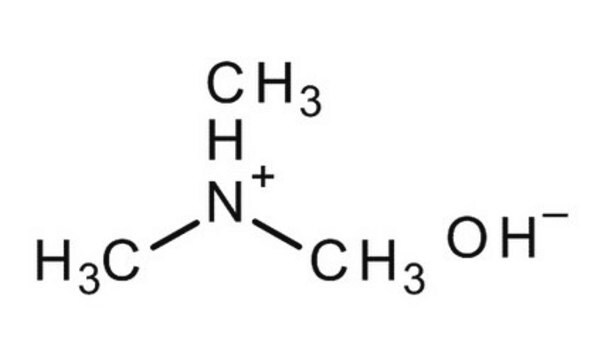92262
Trimethylamine solution
43.0-49.0% in H2O (T)
Synonym(s):
N,N,N-Trimethylamine, N,N-Dimethylmethanamine, TMA solution
Sign Into View Organizational & Contract Pricing
All Photos(1)
About This Item
Linear Formula:
(CH3)3N
CAS Number:
Molecular Weight:
59.11
Beilstein:
956566
EC Number:
MDL number:
UNSPSC Code:
12352100
PubChem Substance ID:
NACRES:
NA.22
Recommended Products
form
liquid
Quality Level
concentration
43.0-49.0% in H2O (T)
density
0.83-0.88 g/mL at 20 °C
functional group
amine
SMILES string
CN(C)C
InChI
1S/C3H9N/c1-4(2)3/h1-3H3
InChI key
GETQZCLCWQTVFV-UHFFFAOYSA-N
Looking for similar products? Visit Product Comparison Guide
Application
Trimethylamine solution may be used for the fabrication of polysulfone membranes by introducing benzyl trimethylammonium cation groups. These membranes are useful in the development of anion exchange membrane fuel cells (AEMFCs).
Signal Word
Danger
Hazard Statements
Precautionary Statements
Hazard Classifications
Acute Tox. 4 Oral - Eye Dam. 1 - Flam. Liq. 1 - Skin Corr. 1 - STOT SE 3
Target Organs
Respiratory system
Storage Class Code
3 - Flammable liquids
WGK
WGK 1
Flash Point(F)
19.4 °F - closed cup
Flash Point(C)
-7 °C - closed cup
Personal Protective Equipment
dust mask type N95 (US), Eyeshields, Gloves
Choose from one of the most recent versions:
Already Own This Product?
Find documentation for the products that you have recently purchased in the Document Library.
Customers Also Viewed
Using microbial desalination cells to reduce water salinity prior to reverse osmosis
Mehanna M
Energy & Environmental Science, 3(8), 1114-1120 (2010)
Crosslinked, epoxy-based anion conductive membranes for alkaline membrane fuel cells
Zhou J
Journal of Membrane Science, 350(1-2), 286-292 (2010)
E L Barrett et al.
Annual review of microbiology, 39, 131-149 (1985-01-01)
Trimethylamine oxide, which is found in relatively high concentrations in the tissues of marine animals, serves as an electron acceptor in the anaerobic metabolism of a number of bacteria associated primarily with three environments: the marine environment (e.g. Alteromonas and
M Al-Waiz et al.
Clinical pharmacology and therapeutics, 42(5), 588-594 (1987-11-01)
Trimethylamine (TMA) and its N-oxide (TMAO) are normal components of human urine. They are present in the diet and also derived from the enterobacterial metabolism of precursors such as choline. Dietary TMA is almost entirely metabolized to and excreted as
S L Hillier
American journal of obstetrics and gynecology, 169(2 Pt 2), 455-459 (1993-08-01)
Bacterial vaginosis is characterized microbiologically by replacement of the Lactobacillus-predominant vaginal flora by Gardnerella vaginalis, Bacteroides species, Mobiluncus species, and genital mycoplasmas. A standardized, laboratory-based diagnostic test for bacterial vaginosis is desirable in those instances in which a microscope is
Our team of scientists has experience in all areas of research including Life Science, Material Science, Chemical Synthesis, Chromatography, Analytical and many others.
Contact Technical Service









